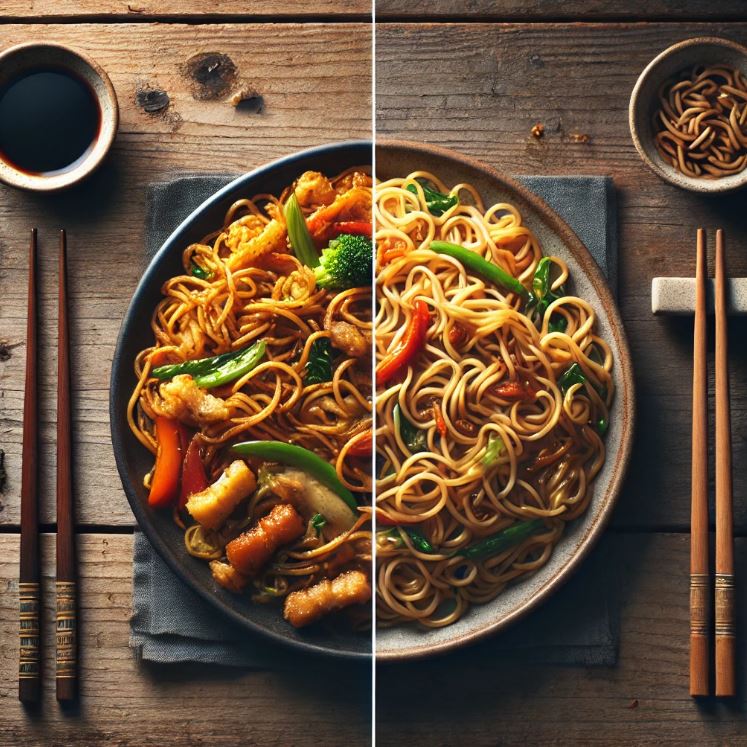Chinese cuisine offers a vast array of delicious dishes, with noodles being a staple in many recipes. Among the most popular noodle dishes are chow mein and lo mein. While they may appear similar at first glance, there are distinct differences between these two beloved dishes. Understanding the difference between chow mein and lo mein can enhance your dining experience and help you appreciate the unique qualities of each. In this article, we’ll explore what sets chow mein and lo mein apart, delving into their ingredients, preparation methods, and flavor profiles.
Key Takeaways
- Chow mein and lo mein are both Chinese noodle dishes, but they differ in noodle type, preparation, and texture.
- Chow mein noodles are typically stir-fried until crispy, while lo mein noodles are boiled and then mixed with sauce and ingredients.
- The choice between chow mein and lo mein often comes down to personal preference for texture and flavor.
Defining Chow Mein
Chow mein, which translates to “fried noodles,” is a popular dish characterized by its crispy texture. The noodles used in chow mein are usually egg noodles, which are first parboiled and then stir-fried until they achieve a delightful crunch. This cooking method gives chow mein its distinctive texture and makes it a favorite for those who enjoy a bit of bite in their noodles. The dish is typically combined with vegetables, meat, and a savory sauce, resulting in a harmonious blend of flavors and textures.
Ingredients and Preparation
The ingredients for chow mein typically include:
- Noodles: Thin egg noodles that are parboiled and then stir-fried.
- Vegetables: Commonly used vegetables include cabbage, bell peppers, carrots, and onions.
- Protein: Options such as chicken, beef, shrimp, or tofu.
- Sauce: A savory mixture often made with soy sauce, oyster sauce, and sesame oil.
The preparation involves stir-frying the noodles until they are crispy and then mixing them with the cooked vegetables and protein. The sauce is added last, allowing it to coat the ingredients evenly and enhance the overall flavor.
Understanding Lo Mein
Lo mein, which translates to “tossed noodles,” offers a different texture and flavor profile compared to chow mein. The noodles used in lo mein are also egg noodles, but they are usually thicker and softer. These noodles are boiled until they are tender, and then they are tossed with a rich sauce and mixed with vegetables and protein. Lo mein is known for its chewy texture and its ability to absorb the flavors of the sauce and ingredients.
Ingredients and Preparation
The ingredients for lo mein typically include:
- Noodles: Thick egg noodles that are boiled until tender.
- Vegetables: Common choices include bok choy, mushrooms, carrots, and snow peas.
- Protein: Options such as chicken, pork, beef, or shrimp.
- Sauce: A flavorful combination often made with soy sauce, hoisin sauce, and sesame oil.
The preparation involves boiling the noodles separately and then tossing them with the cooked vegetables and protein. The sauce is added to the mixture, allowing the noodles to soak up the flavors and achieve a rich, savory taste.
Differences in Texture and Flavor
The primary difference between chow mein and lo mein lies in the texture of the noodles and the cooking method:
- Texture: Chow mein noodles are crispy due to stir-frying, while lo mein noodles are soft and chewy because they are boiled.
- Cooking Method: Chow mein is stir-fried, giving it a crispy texture, whereas lo mein is boiled and then tossed with sauce, resulting in a softer texture.
- Flavor: Chow mein offers a contrast of crispy noodles and tender ingredients, while lo mein provides a more uniform, saucy, and flavorful experience.
Recent Developments
As of June 20, 2024, there have been exciting developments in the culinary world regarding chow mein and lo mein. Chefs are experimenting with fusion dishes, combining traditional Chinese noodles with flavors from other cuisines. For instance, Korean-inspired lo mein with gochujang sauce and Japanese-style chow mein with teriyaki are gaining popularity. These innovative dishes showcase the versatility of chow mein and lo mein and their ability to adapt to global tastes.
Top Experts and Entities in the Field
Several culinary experts and entities have made significant contributions to the popularity and evolution of chow mein and lo mein. Chef Ken Hom, a renowned Chinese-American chef, has written extensively about these dishes, offering insights into their preparation and cultural significance. The James Beard Foundation has recognized numerous chefs for their innovative takes on traditional Chinese noodle dishes, highlighting the ongoing evolution of these beloved meals.
Key Takeaways – Difference Between Chow Mein and Lo Mein
- Chow mein is characterized by its crispy noodles, while lo mein features soft, chewy noodles.
- The primary differences lie in the cooking methods and textures.
- Recent culinary trends are incorporating global flavors into traditional chow mein and lo mein dishes.
Conclusion
Understanding the differences between chow mein and lo mein can enhance your appreciation of these delicious dishes. Whether you prefer the crispy texture of chow mein or the saucy, tender noodles of lo mein, both offer unique and delightful dining experiences. The next time you’re at a Chinese restaurant or cooking at home, you’ll be able to make an informed choice and enjoy the flavors that best suit your palate.
Author: HowDiff
HowDiff is an expert in identifying and explaining the differences between various subjects, helping people understand subtle distinctions and unique characteristics with clarity and insight.
